(excerpted and adapted from A Brief History of Tassajara by Marilyn McDonald)
Native Americans at Tassajara
Native North Americans were the first humans to enjoy the waters of Tassajara Hot Springs. The group called the Esselen made this area their home. Indians had many uses for the hot springs: as preparation for the hunt, as a place for renewing spiritual energy, and as a … sweat lodge for deep cleansing of their bodies and ridding themselves of vermin.
The name Tassajara is most likely corruption of the Spanish word tasajera, which means a place where meat is dried. Summers are often hot at the springs, which makes it an ideal place to dry meat outdoors. The Tassajara area had the company of numerous beasts: foxes, bobcats, raccoons, coyotes, mountain lions, skunks, rattlesnakes, and an abundance of grizzly bears, who often stood 7 feet tall and weighed 850 pounds.
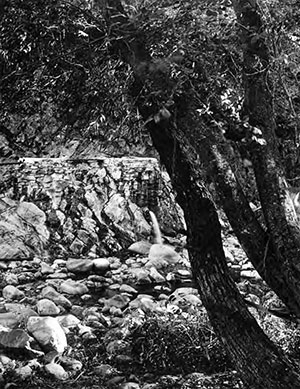
In the early 1800s Indians from many different tribes came to Tassajara for the waters. In 1843 Jack Swan, well heading back to Monterey after a hunting trip, met a party of Indians coming up the Carmel Valley on their way to Tassajara. They planned to build a sweat hut at the hot springs in the hope of curing a skin disease that had broken out among them. In further describing the springs, Swan wrote at that time:
Frequently there would be several tribes there at one time but because of the great abundance of wild game of all kinds and fish they had no trouble living.
Salinas Californian, June 22, 1963
First Owners, Developing the Road
Inaccessibility probably prevented regular trips by the early Spanish settlers in the Monterey area. In a 1969 report to the state surveyor general, the Monterey county assessor made these comments:
The healing qualities of a hot mineral spring which, although known since the early days of the settlement of California, has been until now unappreciated… There exists a large cave covered on the inside with Indian hieroglyphics… Near this cave and in close proximity to a fine mountain stream abounding in trout, is a sulfur spring, the temperature of which is nearly 160°. The spring has lately been resorted to by persons afflicted with rheumatic complaints, and the effects, according to the testimony of those who have visited the locality, have been wonderful.
The gold rush of 1849, the completion of the Central Pacific Railroad in 1869, and the depression of 1873 all brought people to the West Coast. The first “settler” was J. E. Rust, who stayed only long enough to build one cabin, then moved on. “Squatters rights” changed hands a few times, and was acquired by William Hart In November 1876; who wanted to develop it for guests. He put up some tents and widened the trail in anticipation of the summer. A young woman wrote this letter to the Salina city index in June 1879:
In regard to the trail from James Ranch to the Springs, our party pronounce it in excellent condition. The country is very rough but on a sure-footed animal one can trot at a brisk pace much of the way... Much of the distance is through beautiful scenery - shady groves of oak and sycamore, interspersed with some find specimens of madrone trees and a large variety of undergrowth, including the aromatic mountain laurel or bay tree, yerba santa so valuable for its medicine properties. There are several resting places on the route where travelers can quench their thirst at cold sweet springs, and let their animals feast on the luxuriant undergrowth of wild oats found on the mountain sides.
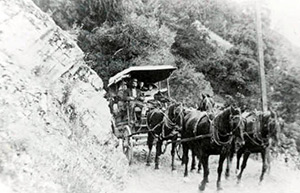
In 1885 ownership passed to Charles Quilty, who hired a surveyor and started work on the road from James Ranch to Chew’s Ridge. The road was mostly completed by a horse drawn plow; local laborers did the work. From the summit down, the work was done by hand with pick, shovel, and blasting powder. There were numerous unemployed Chinese miners and railroad builders in San Francisco and San Jose who would work for $.50 a day and provide their own food. China Camp, on the Tassajara Road, is named after the workers who live there during construction of the road.
The Hotel and Resort
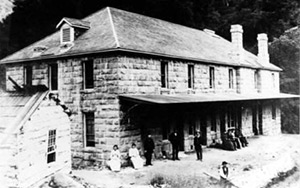
In 1888 with the road completed, the Quiltys turned their attention to building a hotel. Sandstone was chosen as the building material because if it’s abundance in Tassajara Canyon. The property had many large boulders that were blasted and cut on the site. There may have also been sandstone brought from the side canyon up the road. Charles Quilty hired Henry Arnold of Jamesburg to blast the rock and cut the blocks, and most likely he hired Italian stonemasons from San Jose to help with the cutting and Chinese laborers to help with the actual building. Given the location, it was quite an impressive structure. [photo page 20]
Quilty died in 1914; his widow Helen took over the operation of the resort and arranged with a local man named Ira Bailey for the first automobile transport across the road. Bailey said,
It was such a scary road that people got in there and although they wanted to go out, you couldn’t hire ‘em to go ‘til they got their courage back. By that time, the charm of the place got hold of ‘em and they wanted to stay on.
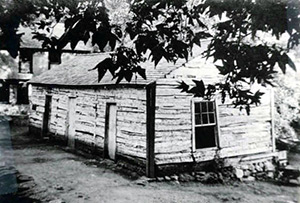
By 1932 there were two Pierce-Arrow stages; one seated 9 and the other 11. They drove round trip from Salinas to the Springs every day, also bringing groceries and supplies. Many of the guests at the Springs in the early 1930s were second and third generation Tassajara devotees. Their parents had come in the late 1800s and brought their children from the time they were little. A number of these children became successful business people in Salinas, Watsonville, and Monterey. Tassajara was a great place to get away from business and relax.
In May 1945 Ralph “Cocky” Meyers and James Bundguard bought Tassajara from Helen Quilty-Holohan. Myers had worked at the Springs as a lifeguard and maintenance man while he was going to school …. At the time of the purchase he was the owner of a large growing, packing, and shipping company in Salinas. … Myers wanted to develop Tassajara into an exclusive resort. He planned to bulldoze the hill behind the plunges and build a helicopter landing pad with a tram car that would cross the stream and bring the passengers safely and smoothly to the door of the hotel. He also planned to initiate a helicopter shuttle service from the city to Tassajara and try to gain the interest of San Francisco businessman….
In 1946, Ralph Myers was killed in an airplane crash, and his wife [also named] Helen decided to open the Springs on her own. She started to remodel and update the old buildings at Tassajara. In the hotel, she added a bathroom for every room, put in new wiring and plumbing, added a new asbestos shingle roof, and bought new carpet, new mattresses, and wool blankets for all the beds. The lobby was decorated with big leather armchairs, thick rugs, and beautiful lamps. Helen Meyers had the interior and exterior of the Club House, dining room, and the stone bathhouse buildings sandblasted, restoring them to their original rock. All the cabins were painted inside and out. The front would be bright yellow, the sides orange or blue, each side a different color.
On September 9, 1949 a fire started in the cabin that was used by Helen Myers-Terry [remarried] as a nursery for the three Myers children. Although there are many versions of the origin of the fire, the truth still remains a mystery. The flames went from the cabin to the treetops and then to the eaves of the hotel which burned for four days. There were forty guests and twenty-two employees present and everyone pitched in to fight the blaze. No one was seriously injured.
Recent Years
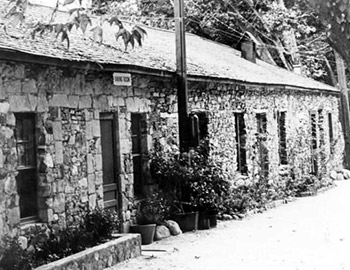
Tassajara changed hands several times and finally passed into the ownership of Robert and Anna Beck in 1960. The Becks had come to Tassajara as guests. Anna Beck sold her antique business in San Francisco and Robert resigned a teaching position. Robert said,
We didn’t have sense enough to know you didn’t move to Tassajara in the winter on that road. In March 1960 [we] started taking great truckloads of our personal belongings and immediately got stuck In the mud. One time the truck started sliding off the road – it was just chaos the whole time… We had sold everything and I quit my job and there we were in the resort business. Then we began to find out how really run down the whole place was.
The buildings and equipment were in constant need of repair. Robert read how-to books. He and Anna built retaining walls, opened the baths to light and air by taking down the glass/brick wall across the front, and converted the pine barroom to guestrooms. In the stone bathhouse they installed showers, built terraces in the back, and put on a double tiered roof to provide better drainage and make the rooms cooler. They created a lake above the baths by the by building a dam, part of which is still standing. The generator would break, the telephone was constantly out of order, and the water system was always in need of repair.
When Anna and Robert stayed at Tassajara in the winter, they would borrow carrier pidgeons from Barry Brothers Feed Store in Monterey. When the telephone and the road were both out, they would put a message in a capsule, strap it to the pigeon’s leg, and let it go. It would fly back to Barry Brothers and someone would send help.
In 1964 Anna Beck gave birth to a son. She ran the Springs during the week and Robert taught school in Monterey and commuted to Tassajara on the weekends. They began to realize Tassajara was more than they could handle, especially with no capital. “One time I figured what we owed and the profit we had made,” Robert recalled. “I figured for the time we had put in we had made $.25 an hour.“ They decided to sell the Springs, and began to advertise. In late December 1966 the San Francisco Zen Center had just raised enough money for a down payment on the Becks’ undeveloped horse pasture property. Then the Becks and Zen Center President Richard Baker came to an agreement to apply the money towards the purchase of Tassajara for $300,000. The Beck’s had planned on selling Tassajara for more, but they really wanted the Zen Center to have it.